Geissorhiza mathewsii
Geissorhiza mathewsii L.Bolus
Family: Iridaceae
Common names: Mathews’ winecup (Eng.), kelkiewyn (Afr.)
Introduction
Each spring, the Darling area bursts into a spectacle of colour, drawing wildflower enthusiasts from across the world to marvel at its remarkable diversity of geophytes, and especially the rare and radiant winecups, of which the elusive Geissorhiza mathewsii is the rarest of them all.
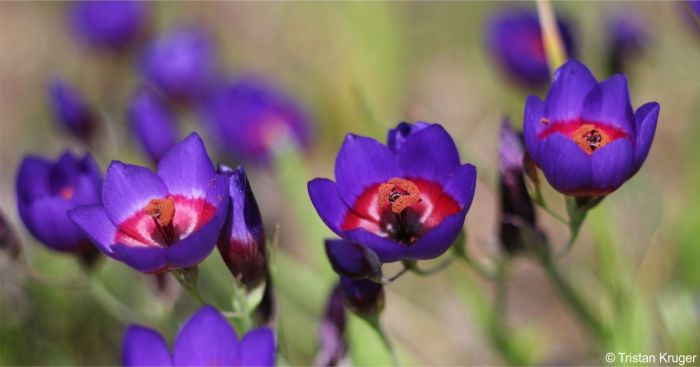
Description
Description
A dwarf, deciduous, cormous geophyte that grows from late autumn until late spring when rains are abundant in its native range, and remains dormant in the dry summer months as a corm sheltered from the harsh elements in the soil. Plants are small, only 180 mm tall at most, and are easily identified by their cupped, deep blue flowers with a red centre edged with or without a narrow white band, broad style branches, and three orange-brown, horizontal anthers held above the style branches. Leaves are flat, broad and ribbed, while underground, the corms have characteristic overlapping woody tunics that look akin to the overlapping tiles on a roof.

Geissorhiza mathewsii bears a close resemblance to Geissorhiza radians and Geissorhiza eurystigma, which are also found in the Darling area, but can be easily distinguished as follows:
All three species have dark blue flowers with a red centre but G. radians is immediately distinguished from the other two by the narrow white band between the red and blue colours in the flower, and the white or dark pit-like spot in the middle of each tepal.
Both G. mathewsii and G. eurystigma have a large style with flat style branches but G. eurystigma can be distinguished by its densely hairy stigma that is longer than the anthers, where in G. mathewsii the style is smooth to the naked eye and is hidden below the anthers. Furthermore, the anthers of G. mathewsii arch inward and are held almost horizontal and hide the style branches, where those of G. eurystigma are erect and the style branches are held above the anthers. In G. radians the stamens and style are on one side of the flower and bend away from the centre, and the style branches are slender, linear and thread-like, and slightly longer than the stamens.
Both G. mathewsii and G. eurystigma have broad, ribbed leaves, but G. radians has linear to cylindrical leaves.
Both G. mathewsii and G. eurystigma have radially symmetric (actinomorphic) flowers but G. radians has zygomorphic flowers that can be divided into only two equal halves.
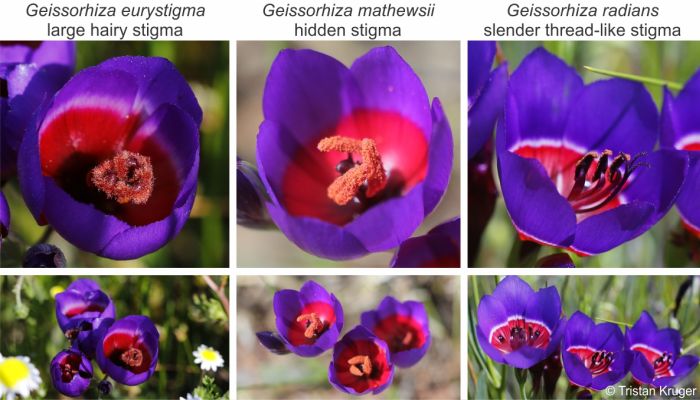
Conservation Status
Status
Assessed as Endangered (EN) by the Red List of South African Plants, Geissorhiza mathewsii has lost 68% of its habitat to crop cultivation and faces ongoing threats from habitat loss and degradation caused by invasive annual grasses and Port Jackson (Acacia saligna), which outcompete and exclude native flora in the seasonally wet habitats where this species occurs. The few remaining populations are also under pressure from agricultural expansion, overgrazing, and trampling.
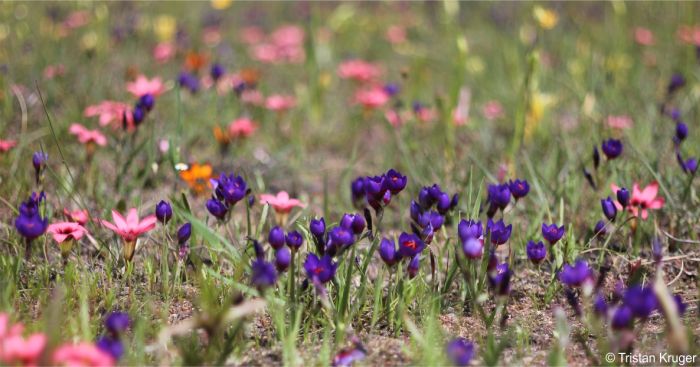
Distribution and habitat
Distribution description
Geissorhiza mathewsii is a rare and local endemic of the Darling area in the Western Cape, where it grows in seasonally wet sands over clay that are waterlogged during the winter rainfall season. This region experiences hot and dry summers, and cool wet winters with occasional light frosts.
Derivation of name and historical aspects
History
The genus name, Geissorhiza, is derived from the Greek geisson which refers to a tile and rhizon, root, alluding to the overlapping tile-like appearance of the tunics on the corm. The specific epithet mathewsii is in reference to Mr J.W. Mathews who collected the type specimens in 1923 and served as the first curator of Kirstenbosch Botanical Garden. The common names kelkiewyn and winecup refer to the contrasting red centre of the dark blue cup-shaped flowers, as if filled with red wine.
Geissorhiza, a genus of about 104 species, is a member of the iris family, Iridaceae, which is composed of approximately 70 genera and 1 800 species worldwide. Other notable genera in the family include the commercially important Gladiolus and Freesia which are important in the cutflower industry, while genera like Ixia, Sparaxis, Moraea and Watsonia are beloved garden subjects.

Ecology
Ecology
The Darling and Mamre areas just north of Cape Town, are especially famous for hosting the group of plants affectionately called the winecups, that bear deep blue-purple flowers with a contrasting red centre. This group is comprised of four Geissorhiza species: Geissorhiza radians, Geissorhiza eurystigma, Geissorhiza monanthos and Geissorhiza mathewsii, and one Babiana species: Babiana rubrocyanea. All of these plants produce their bright contrasting flowers to attract Hopliine (monkey) beetles but are also pollinated by nectarivorous horseflies like Philoliche atricornis, solitary bees and honey bees. Once pollinated, the ovaries rapidly develop, dry and split into three segments and release small unspecialized, brown-orange, spherical seeds when disturbed by animals or wind. These land on the ground nearby the mother plant and as such dispersal is not often far from the mother plant.
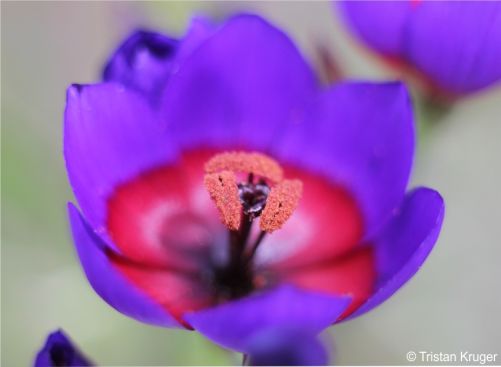
Uses
Use
There are no known medicinal uses for Geissorhiza mathewsii but the winecup flowers are often associated with the annual springtime, Darling Wildflower Show which showcases the flora of the region. The plants of the winecups group are admired by geophyte and flower enthusiasts and are grown as pot plants around the world. Unfortunately, due to the rare nature of Geissorhiza mathewsii, it is rarely commercially available but can potentially be ethically sourced from specialist growers and bulb societies.
Growing Geissorhiza mathewsii
Grow
Geissorhiza mathewsii is best propagated from seed sown at the onset of cooler night temperatures and the arrival of autumn rains in the Western Cape, usually from early autumn. Sow seeds in deep seed trays or beds designated for bulb cultivation in full sun. Use a well-draining soil medium of river sand or Malmesbury sand, and sieve the soil if it contains too many fine clay particles that reduce drainage. Seeds can be sown in rows or evenly scattered, then covered with a thin layer of soil due to their small size. Keep the soil moist at all times, as it must never dry out. Avoid sowing too densely, as overcrowding slows growth and increases the risk of fungal disease. Once germinated, keep seedlings moist and apply an organic foliar spray regularly. Watering should continue until the leaves begin to yellow near the end of spring, at which point watering should stop to allow the little corms to enter dormancy. Leave the seedlings undisturbed for another full season before lifting and dividing them. Store corms in breathable brown paper bags in a cool, dry place over summer and replant them when the growing season begins again. Some seedlings may flower in their second year of growth.
Mature plants grow best in full sun under potted culture. Deep plastic or clay pots are ideal, as they retain moisture and buffer temperature fluctuations. Plant corms in autumn, placing them at a depth two to three times their height in a well-draining medium such as river sand or Malmesbury sand that has been sieved to remove excess clay. More expensive mediums like akadama and pumice are also very useful but can be expensive and require more regular watering. Before planting, mix an organic fertilizer containing phosphorus into the root zone and space the corms evenly so they do not compete for nutrients. After planting, soak the soil thoroughly until water drains from the bottom of the pot, then withhold further watering until leaves appear. Once the first leaves emerge, water regularly to prevent the soil from drying out, as drying will induce premature dormancy. Plants benefit from organic foliar sprays throughout the growing season. Snails and slugs may feed on the leaves and flowers during the wet winter months, but this can be managed using beer traps, organic snail pellets, or manual removal at night.
Flowering typically occurs in late winter and spring, from late August to early October. During this period, hand-pollinate flowers to increase seed stock and maintain a backup to the mother plants. If cultivating more than one winecup species, use a pollinator exclusion structure for outdoor setups to prevent cross-pollination and hybridisation. If seed production is not desired, remove flower spikes soon after blooming to allow the corms to build reserves for the following season. As temperatures rise, aphids and thrips may infest leaves and flower spikes, causing deformation or flower loss if untreated. Remove them manually if numbers are low, or use an organic pyrethroid spray for severe infestations. Products containing garlic are particularly useful, as they also deter future infestations.
Once flowering ends and the leaves begin to yellow, stop watering to allow dormancy. After the plants have fully died back, lift the corms and inspect them for pests and disease. Mealybugs are often found on dormant corms and can be removed by hand before dusting the corms with flowers of sulphur or diatomaceous earth. During the growing period, premature leaf yellowing and flower abortion may indicate a Pythium or Fusarium infection affecting the entire pot. In such cases, flush the soil with a solution containing the active ingredient dimethyl-didecyl-ammonium chloride at the recommended dosage. This treatment is safe for plants and, with repeated applications, effectively eliminates pathogens even in poorly draining soils.
References
- Goldblatt, P. & Manning, J.C. 2020. Iridaceae of southern Africa. Strelitzia 42. South African National Biodiversity Institute, Pretoria.
- Goldblatt, P., Turner, R.C. & Raimondo, D. 2021. Geissorhiza mathewsii L.Bolus. National Assessment: Red List of South African Plants version 2024.1. https://redlist.sanbi.org/species.php?species=1535-62.
- Koekemoer, M., Steyn, H.M. & Bester, S.P. 2023. Flowering plant families of southern Africa. Strelitzia 46. South African National Biodiversity Institute, Pretoria.
- Lombard, N. 2024. Babiana rubrocyanea (Jacq.) Ker Gawl. (Iridaceae). PlantZAfrica. Online. https://pza.sanbi.org/babiana-rubrocyanea.
- Notten, A. 2001. Lachenalia mathewsii W.F.Barker (Hyacinthaceae). PlantZAfrica. Online. https://pza.sanbi.org/lachenalia-mathewsii.
- Shanks, G. 2008. Geissorhiza radians (Thunb.) Goldblatt (Iridaceae). PlantZAfrica. Online. https://pza.sanbi.org/geissorhiza-radians.
- Terminator product brochure. https://www.agriculturalprotection.co.za/pdf/Term_brochure.pdf. Accessed on 2025/11/10.
Credits
Tristan Kruger
Custodians of Rare and Endangered Wildflowers
December 2025
Plant Attributes:
Plant Type: Bulb
SA Distribution: Western Cape
Soil type: Sandy, Loam
Flowering season: Spring
PH: Acid, Neutral
Flower colour: Blue, Purple, Red
Aspect: Full Sun
Gardening skill: Average
Special Features:
Horticultural zones
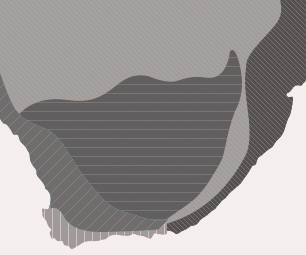







Rate this article
Article well written and informative
Rate this plant
Is this an interesting plant?
Login to add your Comment
Back to topNot registered yet? Click here to register.